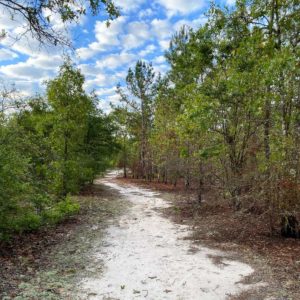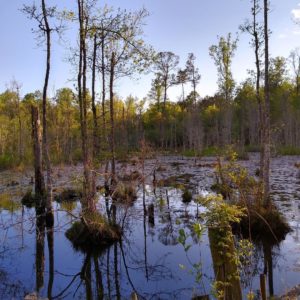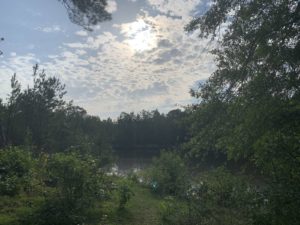
The All You Need Institute (AYNI) sits on the Sandhills of Mississippi in the Piney Woods region, part of what was historically a band of longleaf pine savannah stretching from East Texas to Southern Virginia.
When you enter through our cattle gate as the asphalt road ends, you come upon the start of Springhead Branch, the literal springhead of our local watershed. This basin makes perfect grounds for beavers to place their dams, a keystone holding a thriving wetland community in place. We recommend you stop here to gaze at this charming marsh dotted with water lillies. Often, as if on cue, a great blue heron will leisurely take flight. If you are very lucky the wood stork may motionlessly gaze back at you.

Heading downstream into our land you’d discover an ecologically dynamic zone where the uplands give way to creek bottoms, as braided streams pool and puddle into a confluence with Boggy Branch. Just across our Northern boundary line, in the national forest, if you listen closely you can hear three narrow streams as they converge and gain breadth, dropping into a picturesque pool inviting you to take a dip.
Following the road, though, you’ll find a place to park your car and explore the woody midsection of our land, where gentle hills are carpeted with pine needles. Strolling for just a few minutes, you may be surprised to find the white sands of an ancient dune, heaved hundreds of feet above sea level since the epoch it was formed, a time when shallow oceans covered the great plains and dinosaurs roamed the earth. Here we find the most geologically and ecologically unique feature of the land: the lichen grove.

The dominant vegetation in this surreal landscape is not vegetation at all, instead a partnership between a fungus, which makes up the luffa-esque body, and an algae embedded within, whose chlorophyll gives it the seafoam color. These organisms are “extremophiles”, lovers of harsh environments where, in our case, the plants cede dominance. This landscape looks like something you might find in an alpine tundra of Iceland, miraculously tucked away into Southern Mississippi.
The trees here grow too slowly to shed lichens off their bark, causing many of them to be draped in a fuzzy green coat, creating a whimsical appearance reminiscent of Dr. Seuss or a fairy wonderland. It is no surprise that a close relative of one such type of lichen was dubbed the “pixie cup lichen.”
Surrounding the lichen grove, you may notice the landscape is dominated by pines. From the turn of the century until the 1920’s, old growth longleaf pine savannas were almost entirely clearcut then replanted in tree farms of the faster growing loblolly pine.
As you explore All You Need, you may notice some rows of loblolly pines mixed amongst the turkey oaks and other hardwoods, evidence of an abandoned tree farm. A keen eye might spot the longleaf pines growing against the historical odds in our uplands. Many more mature longleaf pines can be found in our creek bottoms, perhaps having been spared the saw given the difficulty of dragging them out of the muck (muck, being in fact, a technical term in soil science for the substrate of our bottomlands).

Continuing our journey, you’ll come upon what some find the most exciting feature of this land: our largest pond. Very little silt, clay, or decaying vegetation roll down from the dry sandhills above, leaving the water crystal clear. The lack of nutrients means less algae and the bugs that feed on it. This means less food for our resident fish, so don’t be surprised if you get a nibble from a hungry bass! Fear not, there are no trophy bass or other lunkers in this nutrient poor ecosystem.
All of that sand means easy digging for our favorite animal, the All You Need mascot – the gopher tortoise. You may notice the mounds of excavated sand marking the entry to their half moon shaped burrows in the ground. These burrows are shared by literally hundreds of other species, earning the gopher tortoise the honorable designation of keystone species of the longleaf pine savannah. Without them there would be little refuge from blazing summer heat nor the literal blaze of fire that shapes this unique ecosystem.
Without the influence of fire and other ecological disturbances, the canopies of the trees and shrubs would quickly join one another as they stretch out to capture all the sunlight they can. Few rays would make it to the forest floor, and the great diversity of native grasses and wildflowers would dwindle. These plants provide food and shelter to a plethora of animals, including the tortoises and ground nesting birds. This longleaf pine savannah ecosystem has the potential to be one of the most diverse ecosystems in the entire world, but it has dwindled to a mere 3% of its former glory. So what can we do to bring it back, along with the other habitats we steward? Click here to learn more about our conservation efforts.


